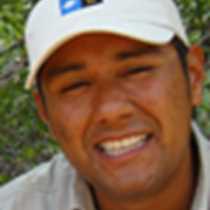Genovesa Island
A collapsed caldera; a deep bay (over 600 feet in places); flying dinosaurs overhead; guano smell in the air; steel gray cliffs all around us, with a fringe of green on top; words written on the wall, slowly but surely disappearing beneath a layer of bird-droppings.
Genovesa has no terrestrial reptiles; they never drifted this far north from the other islands or west from the mainland. As a result, there are soft, hairy cacti inhabiting this island since there is no need for sharp defenses against the large herbivores that never arrived. Marine iguanas are the only reptiles here; small, dark and inconspicuous. But they are not the stars of the show here. Great frigatebirds, red-footed boobies, large cactus finches, Galápagos doves, short-eared owls, Galápagos storm petrels, warbler finches, Nazca boobies, yellow-crowned night herons, striated herons…and there are more!
Bright red gular sacks were shaken and stirred against a chest of black feathers and wings of metallic greenish black; the backdrop is verdant green filled with hollow warbling and drumming. The great frigatebirds are in the throes of courtship (not all males will be successful, but all available females will). Drama played out in front of us this morning in the frigatebird world: twigs stolen, nests usurped, males and females both instinctively knowing that it is a no-holds-barred struggle to get their genes into the next generation.
Snorkeling was great (in my opinion it always is, here in Galápagos). Gigantic bump-headed parrotfish, Moorish idols, sunset wrasses, and a few lucky people saw hammerhead sharks below in the depths.
Mid-afternoon had everyone going ashore again to visit different areas, the opposite of what was visited in the morning; so one group went to the beach while the other climbed the fissure called “Prince Philip’s Steps.”
What a wonderful last day!




